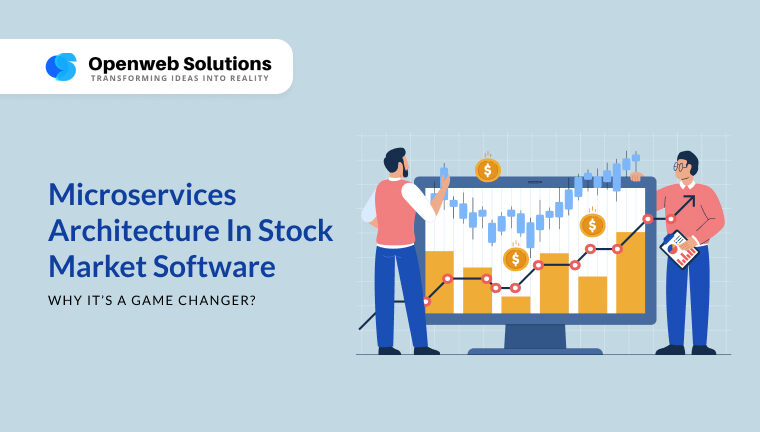Stock market app development is a highly intricate domain requiring superior scalability, real-time data processing capabilities, and robust security mechanisms. The advent of microservices architecture has revolutionized stock market software and website development, offering unparalleled flexibility, resilience, and operational efficiency. This architectural paradigm, characterized by the decomposition of applications into loosely coupled, independently deployable services, is now a cornerstone of modern financial technology.
Understanding Microservices Architecture
Microservices architecture is a software development methodology wherein applications are structured as a suite of small, autonomous services that communicate via well-defined APIs. This approach starkly contrasts with monolithic architecture, where all components are tightly integrated into a single codebase. By decoupling functionalities, microservices facilitate independent development, testing, deployment, and scaling of each service, optimizing both software agility and reliability.
Why Microservices Are Transformative in Stock Market App Development?
1. Enhanced Scalability and Performance
Stock market applications must handle immense data volumes, especially during peak trading sessions. A microservices-based architecture ensures that critical components—such as real-time stock price updates, order execution, and user authentication—function as distinct services. This modularity allows for horizontal scaling, where specific services scale independently based on demand, thereby mitigating system bottlenecks and enhancing resource allocation efficiency.
2. Accelerated Deployment and Development Cycles
Traditional monolithic architectures necessitate redeploying the entire application even for minor modifications, thereby increasing downtime and operational risks. Conversely, microservices architecture enables incremental updates; developers can modify, test, and deploy individual services without impacting the system’s overall stability. This agility is crucial for stock market software development, where rapid bug fixes and feature rollouts are imperative.
3. Robust Security Frameworks
Security is paramount in financial applications. Microservices architecture enhances security through service isolation, meaning that vulnerabilities in one service do not compromise the entire system. Additionally, each microservice can implement tailored security protocols, such as authentication mechanisms, encryption standards, and API gateways, to fortify system integrity and data protection.
4. Real-Time Data Processing and Low Latency Execution
The stock market operates on real-time data, necessitating ultra-fast transaction processing and execution. Microservices facilitate parallel processing by distributing workloads across specialized services—for instance, separate services manage live price tracking, order matching, risk analysis, and settlement processing. This distribution reduces latency and ensures a seamless trading experience.
5. Fault Tolerance and System Resilience
In a monolithic system, a single failure can compromise the entire application. Microservices architecture inherently enhances fault tolerance by compartmentalizing failures; if one service crashes, others remain operational. This ensures high availability and system robustness—critical attributes for stock market applications that demand uninterrupted functionality.
6. Heterogeneous Technology Stack Adaptability
Stock market website development and software engineering often require diverse programming languages and frameworks. Microservices architecture permits a polyglot approach, allowing services to be built using the most suitable technology stack. For example, Python can be leveraged for data analytics, while Java or C++ may be utilized for executing high-frequency trading algorithms.
Challenges in Adopting Microservices in Stock Market Software
While microservices offer profound advantages, their implementation entails challenges:
- Service Orchestration Complexity: Managing numerous independent services necessitates sophisticated orchestration tools such as Kubernetes and service mesh frameworks like Istio.
- Data Consistency and Synchronization: Maintaining consistency across distributed services is challenging and often requires event-driven architectures or distributed consensus mechanisms such as Apache Kafka.
- Increased Security Overheads: With multiple services communicating via APIs, ensuring robust security across numerous endpoints demands stringent authentication and authorization protocols.
Conclusion
Microservices architecture represents a transformative shift in stock market app development, offering unmatched scalability, fault tolerance, and real-time data processing capabilities. Despite inherent implementation challenges, the benefits far outweigh the complexities, making microservices the preferred architectural paradigm for modern stock market software and website development.
FAQs
1. What distinguishes microservices architecture from monolithic architecture in stock market applications?
Ans: Microservices architecture decomposes applications into independently functioning services, whereas monolithic architecture integrates all functionalities into a single unit. This modularity enhances scalability, fault tolerance, and development agility in stock market software.
2. How does microservices architecture enhance real-time data processing in stock market applications?
Ans: By distributing tasks among specialized services, microservices enable concurrent execution of market data tracking, order matching, and risk analysis, significantly reducing latency and improving trading efficiency.
3. What security advantages does microservices architecture offer in stock market app development?
Ans: Microservices ensure service isolation, meaning that vulnerabilities in one service do not compromise the entire system. Independent security mechanisms, including authentication protocols and encryption layers, enhance system security.
4. What are the primary challenges of implementing microservices in stock market software?
Ans: Challenges include complex service orchestration, ensuring data consistency across distributed services, and managing security across multiple microservices APIs.
5. How does microservices architecture support scalability in stock market applications?
Ans: Each service scales independently based on real-time demand, ensuring optimized resource utilization. This horizontal scaling capability is essential for handling peak trading volumes without performance degradation.
By leveraging microservices architecture, stock market applications can meet the growing demands of traders and investors while ensuring a high-performance, resilient, and secure trading experience.
Partha Ghosh is the Digital Marketing Strategist and Team Lead at PiTangent Analytics and Technology Solutions. He partners with product and sales to grow organic demand and brand trust. A 3X Salesforce certified Marketing Cloud Administrator and Pardot Specialist, Partha is an automation expert who turns strategy into simple repeatable programs. His focus areas include thought leadership, team management, branding, project management, and data-driven marketing. For strategic discussions on go-to-market, automation at scale, and organic growth, connect with Partha on LinkedIn.






